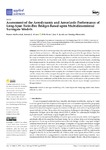Assessment of the Aerodynamic and Aeroelastic Performance of Long-Span Twin-Box Bridges Based upon Multidimensional Surrogate Models

Use this link to cite
http://hdl.handle.net/2183/37641Collections
- Investigación (ETSECCP) [827]
Metadata
Show full item recordTitle
Assessment of the Aerodynamic and Aeroelastic Performance of Long-Span Twin-Box Bridges Based upon Multidimensional Surrogate ModelsAuthor(s)
Date
2024Citation
Badhurshah, R.; Álvarez, A.J.; Nieto, F.; Jurado, J.Á.; Hernández, S. Assessment of the Aerodynamic and Aeroelastic Performance of Long-Span Twin-Box Bridges Based upon Multidimensional Surrogate Models. Appl. Sci. 2024, 14, 5531. https://doi.org/10.3390/app14135531
Abstract
[Abstract:] Twin-box decks are being extensively used in the design of long-span bridges due to their superior flutter performance. Although the significant role played by the gap distance has been previously addressed in the frame of experimental studies, there is still a lack of understanding about the complex interplay between box geometry, gap distance and the aerodynamic force coefficients and flutter derivatives. In the present work, firstly, a surrogate model is developed, considering three design inputs for the geometry of the deck along with the angle of attack, providing the force coefficients as output. Afterwards, the work is then extended by developing another surrogate model, considering as inputs the reduced velocity and the same geometric variables of the deck, with the outputs being the flutter derivatives. The methodology, comprising the selection of the design domain, the definition of the samples, the CFD-based evaluation of the samples' response and the construction of the surrogate through the application of the neural network-based radial basis method, is reviewed. The surrogate models enable a quantitative description of the impact caused in the force coefficients and the flutter derivatives by modifications in the geometry of the twin-box deck. It has been found that flutter derivatives H∗1 , H∗2 and A∗2 are strongly dependent on the gap distance.
Keywords
Twin-box
Surrogate modelling
CFD
Latin Hypercube Sampling
Radial basis
Flutter
URANS
k-ω SST
Surrogate modelling
CFD
Latin Hypercube Sampling
Radial basis
Flutter
URANS
k-ω SST
Editor version
Rights
Atribución 3.0 España






